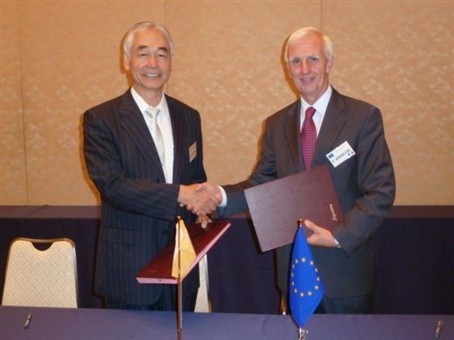F4E and ITER IO sign Procurement Arrangement for the ITER cryoplant


The Procurement Arrangement (PA) for the Liquid Nitrogen Plant and Auxiliary Systems of the ITER cryoplant was signed during the ITER Council meeting in Japan between the F4E Director, Frank Briscoe and Osamu Motojima, Director of ITER International Organization. F4E is in charge of supplying about half of the cryoplant equipment while the other half will be procured by ITER IO. India is responsible for providing the cryodistribution components. F4E is expected to launch the call for the tender for its share during the third quarter of this year.
What is the role of the cryoplant system? Hot plasmas with temperatures above 100 million ºC are needed for the production of fusion energy. The plasmas have to be kept away from the surrounding walls by means of powerful superconducting magnets requiring cryogenic temperatures of a few Kelvin for their operation. These very low temperatures are produced in the ITER cryoplant which will be one of the largest plants of this type in the world. The low temperatures are achieved by means of liquid nitrogen (LN2) and cold helium (He) via processes nowadays well known by industry. The magnets are cooled by circulation of this helium through them. The cryoplant is a non-nuclear facility and will serve magnets, cryopumps, diagnostics, etc.
Usually in cryogenic systems the equipment that needs to be kept cold is protected from the heat of the surroundings by thermal shields cooled to 80 K (approximately -200 ºC) with LN2. In ITER, He at 80 K will be used instead. F4E is responsible for the supply of two 80 K He loops with flow rates up to 4 kg per second and two plants for producing the LN2 needed for cooling the helium.
F4E will also supply various auxiliary systems needed for the efficient operation of the cryoplant. For example, facilities to store nitrogen and up to 25 tonnes of helium. In addition, systems to remove impurities from helium are also envisaged.
Further information on the call for tender will be published on the F4E website.
